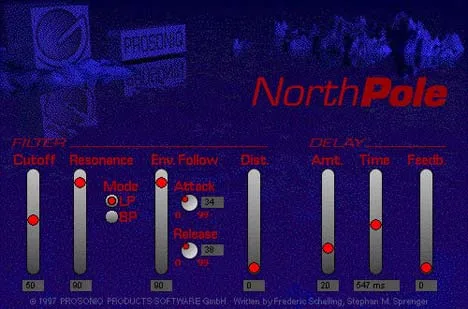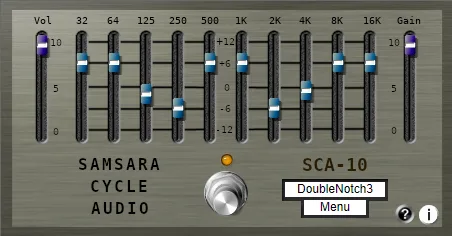In the world of music production and sound design, there are countless tools designed to give sound uniqueness and character. Among them, plugins that skillfully combine several effects occupy a special place, opening up new horizons for creativity. NorthPole by Prosoniq is just such a plugin. It is a powerful combined effect that combines a resonant filter, a distortion block, and a digital delay, offering a comprehensive solution for deep sound transformation.
This plugin is not just a set of standard effects; it is designed in such a way that these components interact, creating rich and dynamic textures. From classic filter sweeps to rhythmic pulsations and rich, spatial sounds – NorthPole can add life and a special flavor to any audio signal.
The Heart of the Plugin: Resonant Filter
The basis of NorthPole is its high-quality resonant filter. It is a 4-pole filter with a slope of 24 dB/octave, which provides a sharp cut of frequencies. It can operate in two modes: Low Pass and Band Pass. Low Pass mode allows you to gradually remove high frequencies, leaving only the “warm” bottom, while Band Pass highlights a certain frequency band, cutting off everything below and above it. This is ideal for isolating certain sound elements or creating a “telephone” effect.
Key controls are Cutoff (cut-off frequency) and Resonance. By moving Cutoff, you determine exactly where the filter will start to act. Increasing Resonance amplifies frequencies immediately before the cut-off point, creating a characteristic “whistling” or “vocal” sound, which is the hallmark of many electronic genres and psychedelic music. Dynamic changes of these parameters allow you to create the famous “filter sweeps”, which add movement and energy to the track.
Dynamic Movement with the Envelope
To make the filter even more interactive and “alive,” NorthPole is equipped with an Envelope Follower. This module analyzes the volume of the incoming audio signal and uses it to automatically control the cut-off frequency of the filter. The louder the signal, the higher (or lower, depending on the setting) the cut-off frequency rises.
The envelope is controlled by the parameters Sensitivity, Attack, and Release. Sensitivity determines how strongly the envelope reacts to changes in volume. Attack sets how quickly the filter reacts to the increase in volume, and Release – how quickly it returns to its original state after the decrease in volume. This allows you to create classic “auto-wah” effects, where the filter opens synchronously with the attack of the note, or more complex rhythmic patterns, when the filter pulsates in time with the drums or other percussive elements.
Add Character: Distortion Block
The next step in the NorthPole signal chain is the distortion block. It adds harmonics and saturation to the sound that has already passed through the filter. This can be either a light saturation to add “warmth” and presence, or an aggressive overdrive or distortion to create more raw and powerful textures.
The presence of an adjustable level of distortion allows you to accurately dose the effect – from a barely noticeable “tinting” to a complete signal overload. Placing this block after the filter means that you can distort the already filtered sound, which opens up additional possibilities for forming a unique timbre. For example, you can filter only low frequencies and then distort them to get a fat bass sound.
Spatial Completion: Digital Delay
The last element in the NorthPole chain is the digital delay block. It receives the output signal that has already passed through the filter and distortion block and creates its repetition. This allows you to add space, depth, or create interesting rhythmic effects based on the processed sound.
Delay parameters include Time (delay time), Mix (ratio of processed and original signal), and Feedback (feedback – number of repetitions). You can set up short, fast repetitions to create a “comb filtering” effect in addition to the main filter, or long, fading echoes from a signal saturated with distortions. Placing the delay at the end of the chain makes it ideal for creating atmospheric tails or rhythmic patterns that repeat the dynamics of the filter and distortions.
NorthPole in Your Production
The combination of a resonant filter with an envelope, flexible distortion, and digital delay makes NorthPole an extremely versatile tool for sound design and music production. It is ideal for processing synthesizer parts, adding movement and aggression to them, for “reviving” static pads, creating interesting effects on bass lines or guitars. It can also be used to shape drum sounds, adding weight and character to them.
Whether you need to create a pulsating bass, a lead synthesizer cutting through the mix with a rich timbre, atmospheric soundscapes that change over time, or just add “warmth” and analog character to digital sound – NorthPole offers intuitive means to achieve these goals. It can be used as a tool for fine correction, as well as for radical sound transformation.
Technical Compatibility
The NorthPole plugin is available in popular VST, AU (Audio Units), and RTAS formats, ensuring its compatibility with most modern digital audio workstations (DAW) on Windows and MacOS operating systems. This makes it easily integrated into your current workflow, regardless of the software you use to create music.
- Supported Formats: VST, AU, RTAS
- Compatible Operating Systems: Windows (Win32), MacOS (OSX)
NorthPole by Prosoniq is more than just a set of effects. It is a creative tool that inspires experimentation and allows you to shape sound with new depth and character. Try it to unlock the full potential of your audio tracks.



